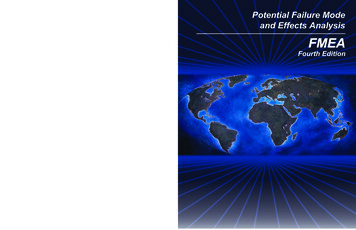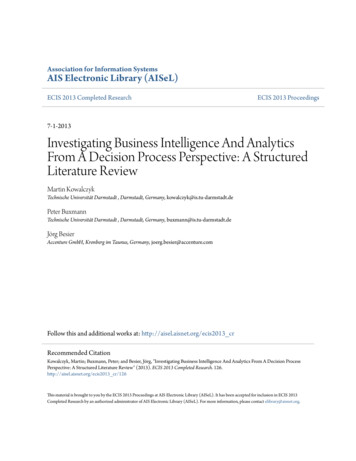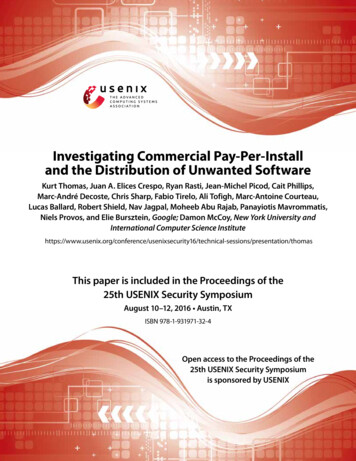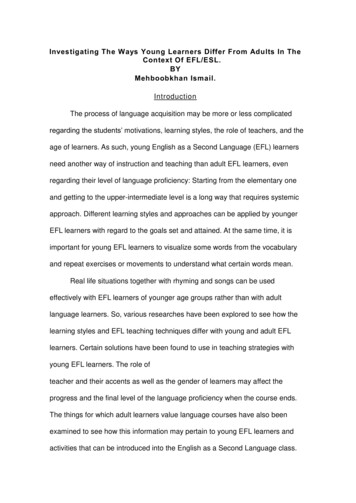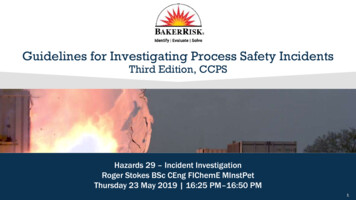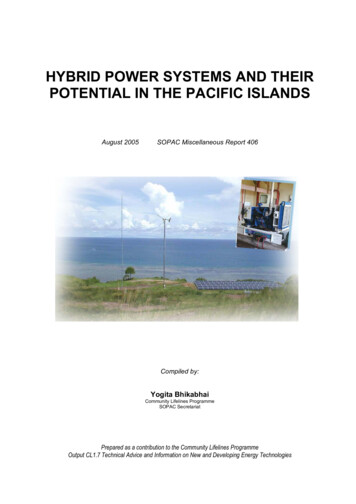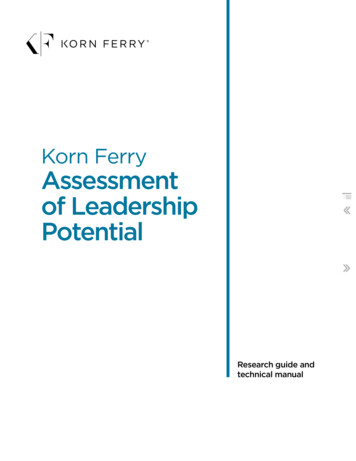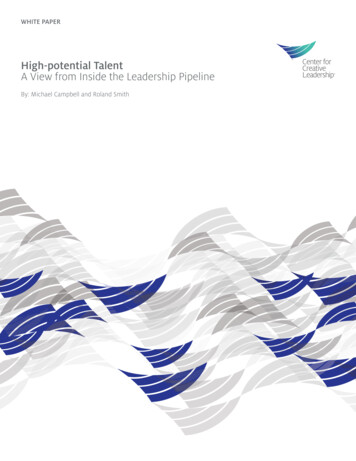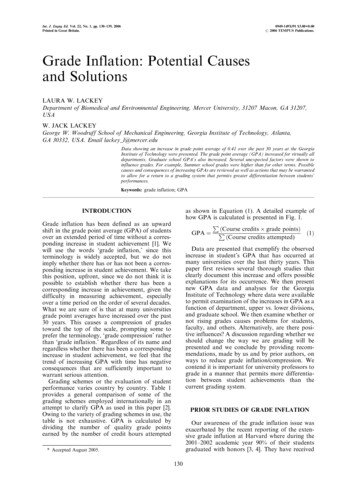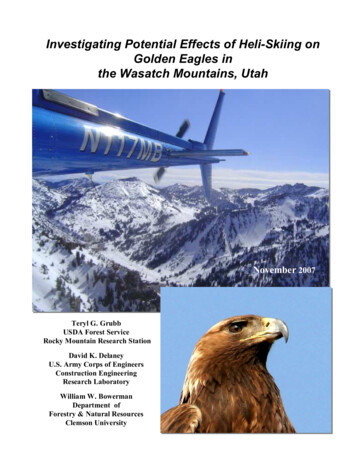
Transcription
Investigating Potential Effects of Heli-Skiing onGolden Eagles inthe Wasatch Mountains, UtahNovember 2007Teryl G. GrubbUSDA Forest ServiceRocky Mountain Research StationDavid K. DelaneyU.S. Army Corps of EngineersConstruction EngineeringResearch LaboratoryWilliam W. BowermanDepartment ofForestry & Natural ResourcesClemson University
Investigating Potential Effects of Heli-Skiing on Golden Eagles inthe Wasatch Mountains, UtahFinal Report to the Wasatch-Cache National ForestStudy No. RMRS-RWU-4251-P2-2Agreement No. 05-JV-11221607-237Teryl G. GrubbUSDA Forest ServiceRocky Mountain Research StationDavid K. DelaneyU.S. Army Corps of EngineersConstruction Engineering Research LaboratoryWilliam W. BowermanDepartment of Forestry & Natural ResourcesClemson University10 November 2007
EXECUTIVE SUMMARYImplementing further research was beyond the scope of the U.S. Forest Service's 2004 FinalEnvironmental Impact Statement (FEIS) and 2005 Wasatch Powderbird Guides (WPG) SpecialUse Permit Renewal process for heli-skiing in the Tri-Canyon Area in the Wasatch Mountains,just east of Salt Lake City, Utah. However, in their Record of Decision the Wasaatch-Cache(WCNF) and Uinta National Forests expressed full support for undertaking a comprehensivestudy to more intensively examine helicopter-golden eagle interactions. This research project isa result of that commitment, with a goal of gathering more specific information on the potentialeffects of heli-skiing operations on golden eagles occupying territories or actively nesting in theTri-Canyon Area, while evaluating the effectiveness of current mitigation and managementpractices identified in the FEIS. Of necessity, this 2006-2007 research project focused primarilyon the helicopter aspects of heli-skiing. It was jointly funded by the U.S. Forest Service WCNFand Rocky Mountain Research Station, the U.S. Army Corps of Engineers ConstructionEngineering Research Laboratory, and Clemson University. Objectives included a golden eagleoccupancy survey, experimental helicopter testing, and a recreational analysis.To establish the context for WPG operations in the Tri-Canyon Area, we collected data on levelsor recent trends in recreational use, avalanche control, population growth, and other helicoptersoperating in the area. We surveyed as many historical golden eagle nest sites as possiblebetween Parley's and Provo Canyons, as well as monitored a number of lower elevation siteswest and south of Salt Lake City used in our experimental testing. Historical records for goldeneagle nesting in the Tri-Canyon Area, as well as WPG operational records for 1974-2007 werereviewed. In the field, we recorded nesting golden eagle responses to Utah National GuardApache AH-64 attack helicopters, WPG's Eurocopter AS350-B3 AStars and Bell 206L4Longranger, Cirque Lodge's Eurocopter EC140 B4, plus other passing civilian helicopters asthey occurred. Data were collected actively through controlled experimentation, and passively,or opportunistically as circumstances permitted.In total, we observed 303 helicopter passes near 30 individual golden eagles in 22 breedingareas, with 227 passes from the Apache experimentation which was designed to approximateWPG normal operations in pattern, timing, and duration. In 2006, 8 active nest sites were testedwith Apaches, 4 sites per day, 2 days per week for 2 weeks between 11-20 April. In 2007, 15sites (including 6 from 2006) were tested, following the same pattern, during 4 weeks between03-26 April. Scheduled flight paths for flyby's included distances of 800, 400, 200, and 100 m.In addition, we tested approach's and popout's where the helicopter flew straight towards, orpopped out from behind, active nest cliffs as it passed directly overhead. Sound levels wererecorded during 7 of 15 separate helicopter tests in 2006 and during 15 of 31 tests in 2007. Wealso compared sound levels of the Apache with the other 3 helicopters involved in this research.Historical records on golden eagle nesting, plus continued sightings from a variety of sources, aswell as current observations during this project, all indicate golden eagles have continued tooccupy the Tri-Canyon Area for decades, despite the dramatic population growth along theWasatch Front approaching 2 million people, and significant increases in recreational activityover the same time period. In the Cottonwood Canyons alone, there are more than 1.5 millionskiers visiting the 4 major resorts and over 15,000 avalanche control explosions per year. Nearly10,000 vehicles per day enter those 2 canyons. There are also a minimum of 8 different nonmilitary organizations flying 17 different helicopters in and around the Tri-Canyon Area,excluding WPG.ii
Historical records for Tri-Canyon Area golden eagle nesting are sketchy at best, with only 8years of confirmed nesting between 1981-2007. During each of those years, WPG operated inthe same drainage 10-37 days between 15 December and 15 April, flying 108-2,836 separatehelicopter flights. The frequency and timing of these flights evidence a lack of effect onsubsequent nesting activity or success, even though many of those flights occurred during earlycourtship and nest repair. During the 34 year period from 1974 through 2007, WPG annualtrends in operating days (average, 62.4) and total helicopter hours (average, 210.6) haveremained essentially level, while skier days (average, 761.0) have gradually increased.Multiple exposures to helicopters during our experimentation in 2006 and 2007 had no effect ongolden eagle nesting success or productivity rates, within the same year, or on rates of renewednesting activity the following year, when compared to the corresponding figures for the largerpopulation of non-manipulated sites. During our active testing and passive observations, wefound no evidence that helicopters bother golden eagles nor disrupt nesting. In 303 helicopterpasses near eagles, we observed no significant, detrimental, or disruptive responses. 96% of 227experimental passes of Apache helicopters at test distances of 0-800 m from nesting goldeneagles resulted in no more response than watching the helicoper pass (30%). No greaterreactions occurred until after hatching when 4 (possibly 3) golden eagles accounted for 5 flattenand 3 fly behaviors at 3 nest sites. None of these responding pairs failed to successfully fledgeyoung, except for 1 nest that fell later in the season. For WPG observations, 2 eagles accountedfor 2 fly behaviors, 1 of which appeared totally unrelated, at 2 locations. All other fly's for bothtypes of helicopters were interpreted as the aircraft precipitating an imminent departure, morethan eliciting an excited, startled, avoidance reaction, which was never observed. Non-attendingeagles or those perched away from the nests were more likely to fly than attending eagles, butalso with less potential consequence to nesting success. Golden eagles appeared to become lessresponsive with successive exposures.Apache helicopters were about 2x louder than the civilian helicopters used by WPG. Sounddecreased with distance, and most dramatically when flights were perpendicular to cliff and ridgelines. Much of helicopter sound energy may be at a lower frequency than golden eagles canhear, thus reducing expected impacts. We found no relationship between helicopter sound levelsand corresponding eagle ambient behaviors or limited responses, which occurred throughoutrecorded test levels (76.7-108.8 dB, unweighted).Results of this research speak directly to considerations important to establishing site-specificbuffers, such as type and duration of anthropogenic activity, intervening topography andvegetation, habituation to existing activities, and local population density of the species inquestion. A typical WPG heli-skiing operation may only have a helicopter at any 1 location for afew min during any given hour, and this usually only happens limited times in any given day,and rarely on consecutive days. The rugged, high-relief topography of the Tri-Canyon Areasignificantly reduces buffer distance requirements because of inherent line of sight and soundbuffering across intervening ridges. Plus, golden eagle nests in the area are typically on tall cliffswell below ridges where their natural placement provides an inherent buffer from helicopterslanding nearby, and skiers navigating adjacent runs. Between all the other aircraft and humanactivities occurring in the Tri-Canyon Area, as well as their long term coexistance with WPG andapparent indifference to current operations, golden eagles in the area appear acclimated tocurrent levels of activity. The limited number of their nest sites under consideration in the Triiii
Canyon Area is only a portion of a larger, continuous golden eagle population of 20-22 recentbreeding areas along the Wasatch Front, all the individual sites of which appear to beintermittently occupied, active, and successful related more to natural phenomena than humaninterference.The most recent federal bald and golden eagle management guidelines further accomodatepossible habituation by excepting recommended helicopter buffers where eagles have ademonstrated tolerance to such activity, which appears to be the case in northcentral Utah andthe Tri-Canyon Area. Our direct and indirect observations indicated no avoidance behavior noreven concern by golden eagles to helicopters. Tri-Canyon Area eagles actually exhibited acasual interest in WPG helicopters and their heli-skiing operation. Finally it should be noted theonly reactions by nest-attending eagles recorded during this entire project occurred afterhatching, which in the Tri-Canyon Area does not happen until approximately 4-6 weeks afterWPG's season ends on 15 April. Thus, our results indicate: 1) there is minimal overlap betweengolden eagles and WPG, with nesting at higher elevations occurring later than may have beenthought previously; 2) when there is simultaneous presence, golden eagles do not seem to bebothered or disrupted by WPG activities; and 3) should egg-laying occur while WPG is stilloperating, incubating golden eagles do not normally react other than to watch the aircraft. Forthe specific question of WPG operating in the Tri-Canyon Area without potentially impactingnesting golden eagles, we found no evidence that special management restrictions are required.(Authors' Note: The results of this research were very much unexpected since helicopters areusually considered more disruptive to bald eagles than any other type of aircraft. Plus, goldeneagles are traditionally thought to be more sensitive, and therefore more responsive, to humanintrusions than bald eagles. However, we found the golden eagles studied during this project tobe just as adaptive, tolerant, and acclimated to human activities as any bald eagles in our ratherconsiderable, collective experience with this species. We hypothesize this may at least be in partdue to the proximity of the large, growing, and outdoor-oriented population of the Salt LakeValley and Wasatch Front. It is unlikely any golden eagles within our study area and beyond aretruly naive to anthropogenic influences, no matter how remote their nesting locations appear tobe. Even so, despite this apparently high tolerance, we would still point out that any activity,initially tolerated or not, in excess or extreme, can cause negative impacts. Nonetheless, withthat said, we found nothing to suggest current levels of WPG heli-skiing operations in the TriCanyon Area have any detrimental effect on resident golden eagles.)iv
ACKNOWLEDGEMENTSThis research project was jointly funded by the Wasatch-Cache National Forest, RockyMountain Research Station, U.S. Army Corps of Engineers Construction Engineering ResearchLaboratory, and Clemson University. In addition, the WCNF Supervisor's Office and Salt LakeRanger District provided vital administrative and logistical support throughout the project,especially Diane Probasco, Richard Williams, and Steve Scheid who have been involved withthe project throughout. Jeff Walkes, Fire & Aviation Staff for the WCNF in 2006, prevailedover nearly insurmountable odds to obtain authorization for research personnel to fly with WPGon a limited basis. There would have been no experimental helicopter testing without theenthusiastic and invaluable cooperation of the Utah National Guard 211th Aviation AttackHelicopter Unit, based in West Jordan, Utah, and the special assistance of senior pilots CW5 DonJacobson and CW3 Mike Pluim. Doug Johnson, Resource Specialist for the National Guard'sCamp Williams also helped with access and field support during both years of the study.Wasatch Powderbird Guides facilitated our efforts with an open-door policy and full access totheir operational records, in addition to providing helicopter support for mitigation surveys andseveral experimental flights. WPG owners, guides, and pilots provided valuable insight intotheir operations and interactions with golden eagles over the years. Classic Helicopters HeadPilot, Mario Nicolette, and Cirque Lodge's Pilot, Andy Oprie, generously arranged for soundtesting of their respective helicopters, plus the Cirque helicopter gave us experimental data forsites in Provo Canyon. Kent Keller, local raptor specialist and golden eagle expert, acquaintedresearch personnel with all of the active golden eagle nest sites used in this study beyond the TriCanyon Area historic locations. He shared historical records, monitored manupulated and nonmanipulated sites each year, and was always available for expert counsel throughout the project.Finally, Mike Wierda from Clemson University, stepped in during the second year of the projectto offer exceptional field, office, and research assistance. Individuals who participated inrecording helicopter test observations at golden eagle nest sites include: Angela Gatto, KarenHartman, Doug Johnson, Kent Keller, Roy Lopez, Bob Piscapo, David Probasco, Steve Scheid,Cecily Smith, Zach Todd, Mike Wierda, and Richard Williams. This has obviously been acooperative project, and the contributions of all who have participated are deeply appreciated.Cover photo credits: Heli-skiing Scene, courtesy of Wasatch Powderbird GuidesGolden Eagle, courtesy of Kent Kellerv
TABLE OF CONTENTSEXECUTIVE SUMMARY . . . . . . . . . . . . . . . . . . . . . . . . . . . . . . . . . . . . . . . . . . . . . . . . . . . iiACKNOWLEDGEMENTS . . . . . . . . . . . . . . . . . . . . . . . . . . . . . . . . . . . . . . . . . . . . . . . . . . .vTABLE OF CONTENTS . . . . . . . . . . . . . . . . . . . . . . . . . . . . . . . . . . . . . . . . . . . . . . . . . . . . viLIST OF TABLES . . . . . . . . . . . . . . . . . . . . . . . . . . . . . . . . . . . . . . . . . . . . . . . . . . . . . . . . viiiLIST OF FIGURES . . . . . . . . . . . . . . . . . . . . . . . . . . . . . . . . . . . . . . . . . . . . . . . . . . . . . . . . xIN MEMORIUM . . . . . . . . . . . . . . . . . . . . . . . . . . . . . . . . . . . . . . . . . . . . . . . . . . . . . . . . . xiiINTRODUCTION . . . . . . . . . . . . . . . . . . . . . . . . . . . . . . . . . . . . . . . . . . . . . . . . . . . . . . . . . 1OBJECTIVES . . . . . . . . . . . . . . . . . . . . . . . . . . . . . . . . . . . . . . . . . . . . . . . . . . . . . . . . . . . . 2Occupancy Survey . . . . . . . . . . . . . . . . . . . . . . . . . . . . . . . . . . . . . . . . . . . . . . . . . . . 2Experimental Testing . . . . . . . . . . . . . . . . . . . . . . . . . . . . . . . . . . . . . . . . . . . . . . . . . 2Recreational Analysis . . . . . . . . . . . . . . . . . . . . . . . . . . . . . . . . . . . . . . . . . . . . . . . . . 2LITERATURE REVIEW . . . . . . . . . . . . . . . . . . . . . . . . . . . . . . . . . . . . . . . . . . . . . . . . . . . . 3STUDY AREA . . . . . . . . . . . . . . . . . . . . . . . . . . . . . . . . . . . . . . . . . . . . . . . . . . . . . . . . . . . 7Location . . . . . . . . . . . . . . . . . . . . . . . . . . . . . . . . . . . . . . . . . . . . . . . . . . . . . . . . . . . 7General Environment . . . . . . . . . . . . . . . . . . . . . . . . . . . . . . . . . . . . . . . . . . . . . . . . 7METHODS . . . . . . . . . . . . . . . . . . . . . . . . . . . . . . . . . . . . . . . . . . . . . . . . . . . . . . . . . . . . . . 14Recreation and Other Tri-Canyon Area Activities . . . . . . . . . . . . . . . . . . . . . . . . . . 14Ski Area Visitation . . . . . . . . . . . . . . . . . . . . . . . . . . . . . . . . . . . . . . . . . . . . 14Utah Transit Authority . . . . . . . . . . . . . . . . . . . . . . . . . . . . . . . . . . . . . . . . . 14Utah Department of Transportation . . . . . . . . . . . . . . . . . . . . . . . . . . . . . . . 14Avalanche Control Data . . . . . . . . . . . . . . . . . . . . . . . . . . . . . . . . . . . . . . . . 14Mill Creek Fee Booth . . . . . . . . . . . . . . . . . . . . . . . . . . . . . . . . . . . . . . . . . . 14Salt Lake Area Population Growth . . . . . . . . . . . . . . . . . . . . . . . . . . . . . . . . 14Helicopters in Tri-Canyon Area . . . . . . . . . . . . . . . . . . . . . . . . . . . . . . . . . . 14Golden Eagle Surveying and Monitoring . . . . . . . . . . . . . . . . . . . . . . . . . . . . . . . . . 15Field Surveys . . . . . . . . . . . . . . . . . . . . . . . . . . . . . . . . . . . . . . . . . . . . . . . . .15Test Site Surveying and Monitoring . . . . . . . . . . . . . . . . . . . . . . . . . . . . . . . 15Mitigation Flights . . . . . . . . . . . . . . . . . . . . . . . . . . . . . . . . . . . . . . . . . . . . . 15Historical Record Search . . . . . . . . . . . . . . . . . . . . . . . . . . . . . . . . . . . . . . . 15WPG Historical Records/Trends . . . . . . . . . . . . . . . . . . . . . . . . . . . . . . . . . . . . . . . 16Historical Records . . . . . . . . . . . . . . . . . . . . . . . . . . . . . . . . . . . . . . . . . . . . .16Helicopter Flights and Trend Variables . . . . . . . . . . . . . . . . . . . . . . . . . . . . 17Combined Helicopter Methods . . . . . . . . . . . . . . . . . . . . . . . . . . . . . . . . . . . . . . . . . 17Study Design . . . . . . . . . . . . . . . . . . . . . . . . . . . . . . . . . . . . . . . . . . . . . . . . . 17Units of Measure and Definitions . . . . . . . . . . . . . . . . . . . . . . . . . . . . . . . . . 17Aircraft Types . . . . . . . . . . . . . . . . . . . . . . . . . . . . . . . . . . . . . . . . . . . . . . . . 18Apache Helicopter Testing . . . . . . . . . . . . . . . . . . . . . . . . . . . . . . . . . . . . . . . . . . . . 25Apache Test Patterns . . . . . . . . . . . . . . . . . . . . . . . . . . . . . . . . . . . . . . . . . . 25Observing Golden Eagle Responses. . . . . . . . . . . . . . . . . . . . . . . . . . . . . . . 26Variable Grouping . . . . . . . . . . . . . . . . . . . . . . . . . . . . . . . . . . . . . . . . . . . . .26Test Week Analyses . . . . . . . . . . . . . . . . . . . . . . . . . . . . . . . . . . . . . . . . . . . 26Software and Data Analyses . . . . . . . . . . . . . . . . . . . . . . . . . . . . . . . . . . . . . 26Sound Analysis . . . . . . . . . . . . . . . . . . . . . . . . . . . . . . . . . . . . . . . . . . . . . . . . . . . . . 30Sound Measurements . . . . . . . . . . . . . . . . . . . . . . . . . . . . . . . . . . . . . . . . . . 30Sound Metrics . . . . . . . . . . . . . . . . . . . . . . . . . . . . . . . . . . . . . . . . . . . . . . . . 30vi
RESULTSRecreation and Other Tri-Canyon Activities . . . . . . . . . . . . . . . . . . . . . . . . . . . . . . 35Recreation and Other Activities . . . . . . . . . . . . . . . . . . . . . . . . . . . . . . . . . . 35Population Growth . . . . . . . . . . . . . . . . . . . . . . . . . . . . . . . . . . . . . . . . . . . . 35Golden Eagle Surveying and Monitoring . . . . . . . . . . . . . . . . . . . . . . . . . . . . . . . . . 38Tri-Canyon Area Nesting . . . . . . . . . . . . . . . . . . . . . . . . . . . . . . . . . . . . . . . 38Mitigation Flights . . . . . . .
Longranger, Cirque Lodge's Eurocopter EC140 B4, plus other passing civilian helicopters as they occurred. Data were collected actively through controlled experimentation, and passively, or opportunistically as circumstances permitted. In total, we observed 303 helicopte
